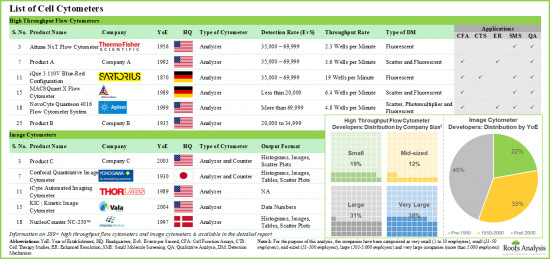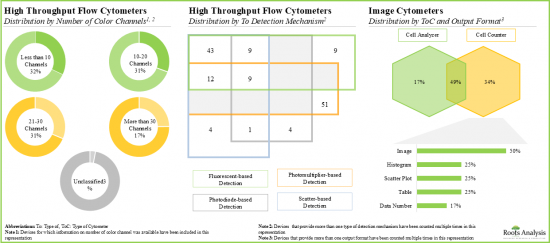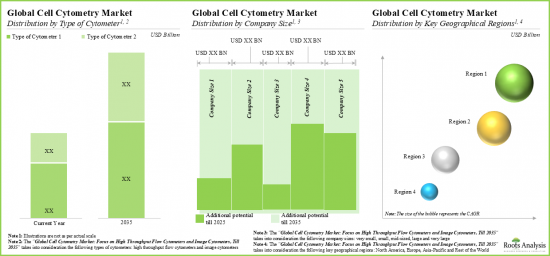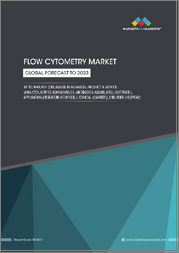
|
시장보고서
상품코드
1771311
세계의 세포 사이토메트리 시장 : 업계 동향 및 예측 - 세포 사이토미터 유형별, 기업 규모별, 지역별, 주요 기업Cell Cytometry Market: Industry Trends and Global Forecasts - Distribution by Type of Cell Cytometer, Company Size and Geographical Regions and Leading Players |
||||||
세계의 세포 사이토메트리 시장 : 개요
세계의 세포 사이토메트리 시장 규모는 2035년까지 예측 기간 동안 10.1%의 연평균 복합 성장률(CAGR)로 확대될 전망이며, 현재 18억 2,000만 달러에서 2035년까지 52억 6,000만 달러로 성장할 것으로 예측됩니다.
시장 세분화는 시장 규모 및 기회 분석을 다음 매개 변수로 구분합니다.
세포 사이토미터 유형별
- 하이 스루풋형 플로우 사이토미터
- 이미지 사이토미터
기업 규모별
- 소규모
- 소규모
- 중규모
- 대규모
- 초대규모
지역별
- 북미(미국, 캐나다, 멕시코)
- 유럽(프랑스, 독일, 이탈리아, 스페인, 영국, 기타)
- 아시아태평양(중국, 일본, 인도, 한국, 호주, 러시아, 태국, 말레이시아, 인도네시아 등)
- 중동 및 북아프리카(이란, 사우디아라비아, 이집트)
- 라틴아메리카(브라질, 아르헨티나, 기타)
세계의 세포 사이토메트리 시장 : 성장 및 동향
세포 사이토메트리는 세포의 분석 및 특성 분석에 이용되는 분석 기술입니다. 근래, 이 기술은 헬스케어 및 제약 업계에서 큰 지지를 얻고 있으며, 특히 바이오마커의 동정이나 약역학과 약동학의 관계의 평가에 이용되고 있습니다. 또한 면역계에 대한 표적 치료제의 효과를 평가할 때도 세포 사이토미터는 중요한 역할을 하고 있습니다. 최신 세포 사이토미터는 면역세포 집단의 상세한 특성 분석과 다양한 질환에 대한 반응을 가능하게 하여 생물학적 샘플을 해석하기 위한 범용성 높은 도구가 되고 있습니다. 만성질환의 세계적 증가에 따라 세포 사이토메트리와 같은 고도의 생물분석 기술에 대한 수요는 지속적으로 증가하고 있습니다.

기초 연구부터 창약, 임상 진단에 이르기까지 세포 사이토메트리의 용도 범위는 넓고, 면역 반응의 해명, 질병의 진행 추적, 세포 메커니즘의 해명 등, 매우 귀중한 툴이 되고 있습니다. 그 결과, 많은 업계 관계자는, 하이 스루풋 기능, 다중화 옵션, 강화된 데이터 해석 툴을 특징으로 하는 선진적인 세포 사이토메트리 기술의 개발을 향한 연구 활동에 주력하고 있습니다.
세계의 세포 사이토메트리 시장 : 주요 인사이트
이 보고서는 세계 세포 사이토메트리 시장의 현재 상태를 파악하고 업계 내 잠재적 성장 기회를 확인합니다. 본 보고서의 주요 조사 결과는 다음과 같습니다.
- 현재, 220개가 넘는 세포 사이토메트리가 폭넓은 임상 연구 및 연구 개발 용도로 사용 가능하며, 이들 대부분은 미국 기업에 의해 개발되고 있습니다.
- 시장 상황는 복수의 검출 메커니즘과 칼라 채널을 이용해 세포를 카운트해, 선별하는 다양한 세포 사이토메트리를 특징으로 하고 있습니다.
- 10 미만의 컬러 채널을 사용하는 높은 처리량 플로우 사이토미터의 대부분(91%)은 미국 기업이 개발하고 있습니다.

- 경쟁 우위를 구축하기 위해 이해관계자는 각각의 사이토미터의 포트폴리오에 선진적인 기능을 짜넣어 진화하는 업계 벤치마크에 준거하려고 적극적으로 노력하고 있습니다.
- 사이토미터의 보급에 수반해, 복수의 업계 기업이 고 처리량 플로우 사이토미터나 이미지 사이토미터에 관해서 복수의 계약을 맺고 있습니다.
- 전년의 제휴수는 최대로, 그 대부분이 판매 계약과 인수였습니다.
- 특필해야할 것은 북미에 본사를 두는 기업에 의한 인수입니다(75%)
- 세포 사이토메트리 분야의 기회를 깨달은 일부 투자자는 선진적인 기능을 갖춘 사이토미터 개발을 지원하기 위해 총액수 100만 달러를 투자하고 있습니다.
- 벤처 라운드에 의한 조달액의 대부분(-90%)은 벤처 시리즈 B와 D에 의해 보고되고 있어 이 중 벤처 시리즈 B의 자금 조달 라운드의 사례가 대부분입니다.
- 산업계, 비산업계를 불문하고, 다양한 세계 이벤트에 참가해, 세포 사이토메트리 업계의 연구 성과, 관련 과제, 기회에 대해서 논의했습니다.
- 이 분야의 웨비나의 75%는 최근 2, 3년간에 개최된 것으로, 그 대부분은 Labroots가 주최한 것입니다.
- 세포 사이토메트리와 관련된 특허는 지난 5년간 1,500건 이상이 학계나 산업계의 이해관계자에 의해 취득 및 출원되고 있으며, 그 대부분은 특허출원입니다.
- 시장은 CAGR 10.1%로 성장할 것으로 예측됩니다. 예측되는 시장 기회는 다양한 유형의 사이토미터에 성공적으로 분배될 가능성이 높으며, 북미가 현재 시장 점유율의 대부분을 획득할 가능성이 높습니다.

세포 사이토메트리 시장의 진출기업 예
- Agilent
- Beckton Dickinson
- Beckman Coulter Life Sciences
- Bio-Rad
- Chemometec
- Milkotronic
- PerkinElmer
- Sartorius
- Sony Biotechnology
- Thermo Fisher Scientific
- Union Biometrica
세계의 세포 사이토메트리 시장 : 주요 부문
세포 사이토미터 유형별로, 시장은 고처리량 세포 사이토미터와 이미지 사이토미터로 구분됩니다. 현재 높은 처리량 세포 사이토미터 부문은 세계 세포 사이토메트리 시장에서 최대(-60%)의 점유율을 차지하고 있습니다. 그러나, 세포 형태의 서브셀 시각화를 위한 고해상도 분석 도구에 대한 수요가 증가함에 따라, 이미지 사이토미터 부문은 예측 기간 동안 더 높은 CAGR로 성장할 것으로 예측됩니다.
기업 규모별로 시장은 초소규모, 소규모, 중규모, 대규모형, 초규모 기업으로 구분됩니다. 현재, 초대형 부문은 세포 사이토메트리 시장에서 가장 높은 비율(-40%)을 차지하고 있습니다. 또한 이 부문은 강력한 R&D 능력, 광범위한 판매망, 확립된 브랜드 평가와 더불어 이 영역에서 대기업의 지속적인 노력으로 상대적으로 높은 CAGR로 성장할 가능성이 높습니다.
주요 지역별로 보면, 시장은 북미, 유럽, 아시아태평양, 기타 지역으로 구분됩니다. 현재 북미(-60%)가 세포 사이토메트리 시장을 독점하고, 최대의 수익 점유율을 차지하고 있습니다. 그러나 아시아태평양 시장은 예측 기간 동안 14%라는 높은 CAGR로 성장할 것으로 예측되고 있습니다.
이 보고서는 세계의 세포 사이토메트리 시장을 조사했으며, 시장 개요와 함께 세포 사이토미터 유형별, 기업 규모별 동향, 지역별 동향 및 시장 진출기업 프로파일 등의 정보를 제공합니다.
목차
제1장 서문
제2장 주요 요약
제3장 서문
- 장의 개요
- 세포 사이토메트리
- 세포 사이토메트리의 장점 및 한계
- 세포 사이토메트리에 관한 일반적인 동향
제4장 높은 처리량 플로우 사이토미터 : 시장 상황
- 장의 개요
- 높은 처리량 플로우 사이토미터 : 시장 상황
- 높은 처리량 플로우 사이토미터 : 개발자의 정세
제5장 제품 경쟁력 분석 : 높은 처리량 플로우 사이토미터
- 장의 개요
- 전제 및 주요 파라미터
- 조사 방법
- 제품 경쟁력 분석
제6장 이미지 사이토미터 : 시장 상황
- 장의 개요
- 이미지 사이토미터 : 시장 상황
- 이미지 사이토미터 : 개발자의 상황
제7장 제품 경쟁력 분석 : 이미지 사이토미터
- 장의 개요
- 전제 및 주요 파라미터
- 조사 방법
- 제품 경쟁력 분석
제8장 세계의 세포 사이토메트리 : 기업 프로파일
- 장의 개요
- Agilent
- Beckman Coulter Life Sciences
- Becton Dickinson
- Bio-Rad
- Chemometec
- Milkotronic
- Nexcelom Bioscience
- Sartorius
- Sony Biotechnology
- ThermoFisher Scientific
- Union Biometrica
제9장 세계의 세포 사이토메트리 : 파트너십 및 협력
- 장의 개요
- 파트너십 모델
- 파트너십 및 협업 목록
제10장 최근 동향
- 장의 개요
- 세계의 세포 사이토메트리 : 자금조달 및 투자 분석
- 세계의 세포 사이토메트리 : 세계 이벤트 해석
- 결론
제11장 특허 분석
- 장의 개요
- 범위와 조사 방법
- 세포 사이토메트리 : 특허 벤치마킹 분석
- 세포 사이토메트리 : 특허 평가 분석
- 인용수 상위의 특허
제12장 시장 예측
- 장의 개요
- 주요 전제 및 조사 방법
- 세계의 세포 사이토메트리 시장(-2035년)
- 세계의 세포 사이토메트리 시장 : 세포 사이토미터 유형별
- 세계의 세포 사이토메트리 시장 : 기업 규모별
- 세계의 세포 사이토메트리 시장 : 주요 지역별
제13장 결론
제14장 주요 인사이트
제15장 부록 1 : 표 형식 데이터
제16장 부록 2 : 기업 및 단체 일람
AJY 25.07.21GLOBAL CELL CYTOMETRY MARKET: OVERVIEW
As per Roots Analysis, the global cell cytometry market is estimated to grow from USD 1.82 billion in the current year to USD 5.26 billion by 2035, at a CAGR of 10.1% during the forecast period, till 2035.
The market sizing and opportunity analysis has been segmented across the following parameters:
Type of Cell Cytometer
- High Throughput Flow Cytometers
- Image Cytometers
Company Size
- Very Small
- Small
- Mid-Sized
- Large
- Very Large
Geographical Regions
- North America (US, Canada, Mexico)
- Europe (France, Germany, Italy, Spain, UK, Rest of Europe)
- Asia Pacific (China, Japan, India, South Korea, Australia, Russia, Thailand, Malaysia, Indonesia, Rest of Asia Pacific)
- Middle East and North Africa (Iran, Saudi Arabia and Egypt)
- Latin America (Brazil, Argentina, Rest of Latin America)
GLOBAL CELL CYTOMETRY MARKET: GROWTH AND TRENDS
Cell cytometry is an analytical technique used for the analysis and characterization of cells. Recently, this technique has gained significant traction within the healthcare and pharmaceutical industries, particularly for biomarker identification and for assessing the relationship between pharmacodynamics and pharmacokinetics. Additionally, cell cytometers play a crucial role in evaluating the effects of targeted therapies on the immune system. Modern cell cytometers enable detailed characterization of immune cell populations and their responses to various diseases, making them highly versatile tools for analyzing biological samples. With the global rise in chronic diseases, the demand for advanced bioanalytical techniques like cell cytometry is continuously increasing.

Given the wide applications of cell cytometry ranging from basic research to drug discovery and clinical diagnostics, it has become an invaluable tool for unraveling immune responses, tracking disease progression, and understanding cellular mechanisms. As a result, many industry players are focusing on research efforts to develop advanced cell cytometry technologies featuring high-throughput capabilities, multiplexing options and enhanced data analysis tools.
GLOBAL CELL CYTOMETRY MARKET: KEY INSIGHTS
The report delves into the current state of global cell cytometry market and identifies potential growth opportunities within industry. Some key findings from the report include:
- Presently, over 220 cell cytometers are currently available for use across wide range of clinical studies and research applications; majority of these have been developed by companies based in the US.
- The market landscape features a variety of cell cytometers that make use of multiple detection mechanisms and color channels to count and sort cells.
- Majority (91%) of the high throughput flow cytometers that use less than 10 color channels have been developed by players headquartered in the US.

- In pursuit of building a competitive edge, stakeholders are making an active effort to incorporate advanced features in their respective portfolio of cytometers and comply with evolving industry benchmarks.
- With the growing adoption of cytometers, several industry players have signed multiple agreements for high throughput flow cytometers and image cytometers.
- The maximum number of partnerships were reported in the previous year; most of these deals were distribution agreements and acquisitions.
- Notably, all acquisitions in the industry have been undertaken by players headquartered in North America (75%); majority of these deals are focused on the expansion of product portfolio.
- Having realized the opportunity in the cell cytometry segment, several investors have collectively invested multi-million dollars to aid the development of cytometers with advanced features.
- Majority (~90%) of the amount raised via venture rounds was reported through venture series B and D; of these, most of the instances reported were of venture series B funding round.
- Both industry and non-industry players have participated in various global events to discuss the research outcomes, affiliated challenges as well as opportunities in the cell cytometry industry.
- 75% of the webinars in this domain have been organized in the last couple of years; of these, majority were organized by Labroots.
- More than 1,500 patents related to cell cytometers have been granted / filed by academia and industry stakeholders in the last five years; majority of these were patent applications.
- The market is expected to grow at a CAGR of 10.1%; the projected market opportunity is likely to be well distributed across different types of cytometers; North America is likely to capture majority of the current market share.

Example Players in the Cell Cytometry Market
- Agilent
- Beckton Dickinson
- Beckman Coulter Life Sciences
- Bio-Rad
- Chemometec
- Milkotronic
- PerkinElmer
- Sartorius
- Sony Biotechnology
- Thermo Fisher Scientific
- Union Biometrica
GLOBAL CELL CYTOMETRY MARKET: KEY SEGMENTS
High Throughput Cell Cytometers Segment Occupies the Largest Share of the Cell Cytometry Market
Based on the type of cell cytometers, the market is segmented into high throughput cell cytometers and image cytometers. At present, high throughput cell cytometers segment holds the maximum (~60%) share of the global cell cytometry market. However, due to the rising demand for high resolution analytical tools for the sub-cellular visualization of cell morphology, image cytometers segment is expected to grow at a higher CAGR during the forecast period.
By Company Size, Very Large Companies is the Fastest Growing Segment of the Global Cell Cytometry Market
Based on the company size, the market is segmented into very small, small, mid-size, large, and very large companies. Currently, very large segment captures the highest proportion (~40%) of the cell cytometry market. Further, this segment is likely to grow at a relatively higher CAGR due to the ongoing efforts of large companies in this domain, in addition to their strong R&D capabilities, extensive distribution networks and established brand reputation.
North America Accounts for the Largest Share of the Market
Based on key geographical regions, the market is segmented into North America, Europe, Asia-Pacific and Rest of the World. Currently, North America (~60%) dominates the cell cytometry market and accounts for the largest revenue share. However, the market in Asia-Pacific is expected to grow at a higher CAGR of 14% during the forecast period.
GLOBAL CELL CYTOMETRY MARKET
- Market Sizing and Opportunity Analysis: The report features an in-depth analysis of the global cell cytometry market, focusing on key market segments, including [A] type of cell cytometer, [B] company size and [C] key geographical regions.
- High Throughput Flow Cytometers Market Landscape: A comprehensive evaluation of high throughput flow cytometers, considering various parameters, such as [A] type of high throughput flow cytometer, [B] throughput rate (wells per minute), [C] detection rate, [D] type of plate format(s), [E] number of color channels, [F] number of laser channels, [G] number of detection channels, [H] sample volume (in µl), [I] type of detection mechanism(s) and [J] application(s). Additionally, the section presents a comprehensive evaluation of high throughput flow cytometer developers, based on [A] year of establishment, [B] company size, [C] location of headquarters and [D] leading players.
- Product Competitiveness Analysis: An insightful competitive analysis of high throughput flow cytometers, examining factors, such as [A] developer power and [B] product competitiveness.
- Image Cytometers Market Landscape: A comprehensive evaluation of image cytometers, considering various parameters, such as [A] type of image cytometer, [B] processing time, [C] type of plate format(s), [D] output format(s), [E] sample volume and [F] application(s). Additionally, a comprehensive evaluation of image cytometer developers, based on [A] year of establishment, [B] company size, [C] location of headquarters and [E] leading players (in terms of number of products being offered).
- Product Competitiveness Analysis: An insightful competitive analysis of image cytometers, examining factors, such as [A] developer power and [B] product competitiveness.
- Company Profiles: In-depth profiles of companies engaged in the development / commercialization of cell cytometers, focusing on [A] company overview and [B] recent developments and an informed future outlook.
- Partnerships and Collaborations: An insightful analysis of the deals inked by stakeholders in this domain, based on several parameters, such as [A] year of partnership, [B] type of partnership, [C] most active players (in terms of the number of partnerships signed) and [D] geographical distribution of partnership activity.
- Recent Developments: A detailed analysis of recent developments / trends related to global cell cytometry domain, providing key insights on the funding activity in this domain, based on several relevant parameters, such as [A] year of funding, [B] type of funding, [C] amount invested (USD Million), [D] most active players and [E] most active investors. Additionally, the section presents a detailed evaluation of the global events attended by the participants, based on several relevant parameters, such as [A] year of event, [B] event platform, [C] type of event, [D] most active organizers and [E] most active organizations.
- Patent Analysis: An in-depth analysis of patents filed / granted for cell cytometry, based on various relevant parameters, such as [A] publication year, [B] geography, [C] CPC symbols, [D] emerging focus areas, [E] type of applicant, [F] leading industry players and [G] patent valuation analysis.
KEY QUESTIONS ANSWERED IN THIS REPORT
- How many companies are currently engaged in this market?
- Which are the leading companies in this market?
- What factors are likely to influence the evolution of this market?
- What is the current and future market size?
- What is the CAGR of this market?
- How is the current and future market opportunity likely to be distributed across key market segments?
REASONS TO BUY THIS REPORT
- The report provides a comprehensive market analysis, offering detailed revenue projections of the overall market and its specific sub-segments. This information is valuable to both established market leaders and emerging entrants.
- Stakeholders can leverage the report to gain a deeper understanding of the competitive dynamics within the market. By analyzing the competitive landscape, businesses can make informed decisions to optimize their market positioning and develop effective go-to-market strategies.
- The report offers stakeholders a comprehensive overview of the market, including key drivers, barriers, opportunities, and challenges. This information empowers stakeholders to stay abreast of market trends and make data-driven decisions to capitalize on growth prospects.
ADDITIONAL BENEFITS
- Complimentary PPT Insights Packs
- Complimentary Excel Data Packs for all Analytical Modules in the Report
- 15% Free Content Customization
- Detailed Report Walkthrough Session with Research Team
- Free Updated report if the report is 6-12 months old or older
TABLE OF CONTENTS
1. PREFACE
- 1.1. Scope of the Report
- 1.2. Research Methodology
- 1.2.1. Research Assumptions
- 1.2.2. Project Methodology
- 1.2.3. Forecast Methodology
- 1.2.4. Robust Quality Control
- 1.2.5. Key Considerations
- 1.2.5.1. Demographics
- 1.2.5.2. Economic Factors
- 1.2.5.3. Government Regulations
- 1.2.5.4. Supply Chain
- 1.2.5.5. COVID Impact / Related Factors
- 1.2.5.6. Market Access
- 1.2.5.7. Healthcare Policies
- 1.2.5.8. Industry Consolidation
- 1.3 Key Questions Answered
- 1.4. Chapter Outlines
2. EXECUTIVE SUMMARY
3. INTRODUCTION
- 3.1. Chapter Overview
- 3.2. Cell Cytometry
- 3.2.1. Flow Cytometry
- 3.2.1.1. High Throughput Flow Cytometry
- 3.2.2 Image Cytometry
- 3.2.1. Flow Cytometry
- 3.3. Advantages and Limitations of Cell Cytometry
- 3.4. Prevalent Trends Related to Cell Cytometry
- 3.4.1. Key Historical Trends
- 3.4.2. Geographical Activity
4. HIGH THROUGHPUT FLOW CYTOMETERS: MARKET LANDSCAPE
- 4.1. Chapter Overview
- 4.2. High Throughput Flow Cytometers: Overall Market Landscape
- 4.2.1. Analysis by Type of High Throughput Flow Cytometer
- 4.2.2. Analysis by Throughput Rate
- 4.2.3. Analysis by Detection Rate
- 4.2.4. Analysis by Type of Plate Format(s)
- 4.2.5. Analysis by Number of Color Channels
- 4.2.6. Analysis by Number of Detection Channels
- 4.2.7. Analysis by Number of Laser Channels
- 4.2.8. Analysis by Sample Volume
- 4.2.9. Analysis by Type of Detection Mechanism(s)
- 4.2.10. Analysis by Application(s)
- 4.3. High Throughput Flow Cytometers: Developer Landscape
- 4.3.1. Analysis by Year of Establishment
- 4.3.2. Analysis by Company Size
- 4.3.3. Analysis by Location of Headquarters
- 4.3.4. Most Active Players: Analysis by Number of Products Offered
5. PRODUCT COMPETITIVENESS ANALYSIS: HIGH THROUGHPUT FLOW CYTOMETERS
- 5.1. Chapter Overview
- 5.2. Assumptions / Key Parameters
- 5.3. Methodology
- 5.4. Product Competitiveness Analysis
- 5.4.1. Product Competitiveness Analysis: High Throughput Flow Cytometers offered by Developers based in North America
- 5.4.2. Product Competitiveness Analysis: High Throughput Flow Cytometers offered by Developers based in Europe and Asia-Pacific
6. IMAGE CYTOMETERS: MARKET LANDSCAPE
- 6.1. Chapter Overview
- 6.2. Image Cytometers: Overall Market Landscape
- 6.2.1. Analysis by Type of Image Cytometer
- 6.2.2. Analysis by Processing Time
- 6.2.3. Analysis by Type of Plate Format(s)
- 6.2.4. Analysis by Output Format(s)
- 6.2.5. Analysis by Sample Volume
- 6.2.6. Analysis by Application(s)
- 6.3. Image Cytometers: Developer Landscape
- 6.3.1. Analysis by Year of Establishment
- 6.3.2. Analysis by Company Size
- 6.3.3. Analysis by Location of Headquarters
- 6.3.4. Most Active Players: Analysis by Number of Products Offered
7. PRODUCT COMPETITIVENESS ANALYSIS: IMAGE CYTOMETERS
- 7.1. Chapter Overview
- 7.2. Assumptions / Key Parameters
- 7.3. Methodology
- 7.4. Product Competitiveness Analysis
- 7.4.1. Product Competitiveness Analysis: Image Cytometers offered by Developers based in North America
- 7.4.2. Product Competitiveness Analysis: Image Cytometers offered by Developers based in Europe and Asia-Pacific
8. GLOBAL CELL CYTOMETRY: COMPANY PROFILES
- 8.1. Chapter Overview
- 8.2. Agilent
- 8.2.1. Company Overview
- 8.2.2. Recent Developments and Future Outlook
- 8.3. Beckman Coulter Life Sciences
- 8.3.1. Company Overview
- 8.3.2. Recent Developments and Future Outlook
- 8.4. Becton Dickinson
- 8.4.1. Company Overview
- 8.4.2. Recent Developments and Future Outlook
- 8.5. Bio-Rad
- 8.5.1. Company Overview
- 8.5.2. Recent Developments and Future Outlook
- 8.6. Chemometec
- 8.6.1. Company Overview
- 8.6.2. Recent Developments and Future Outlook
- 8.7. Milkotronic
- 8.7.1. Company Overview
- 8.7.2. Recent Developments and Future Outlook
- 8.8. Nexcelom Bioscience
- 8.8.1. Company Overview
- 8.8.2. Recent Developments and Future Outlook
- 8.9. Sartorius
- 8.9.1. Company Overview
- 8.9.2. Recent Developments and Future Outlook
- 8.10. Sony Biotechnology
- 8.10.1. Company Overview
- 8.10.2. Recent Developments and Future Outlook
- 8.11. ThermoFisher Scientific
- 8.11.1. Company Overview
- 8.11.2. Recent Developments and Future Outlook
- 8.12. Union Biometrica
- 8.12.1. Company Overview
- 8.12.2. Recent Developments and Future Outlook
9. GLOBAL CELL CYTOMETYRY: PARTNERSHIPS AND COLLABORATIONS
- 9.1. Chapter Overview
- 9.2. Partnership Models
- 9.3. List of Partnerships and Collaborations
- 9.3.1. Analysis by Year of Partnership
- 9.3.2. Analysis by Type of Partnership
- 9.3.3. Most Active Players: Analysis by Number of Partnerships
- 9.3.4. Regional Analysis
- 9.3.5. Intercontinental and Intracontinental Agreements
10. RECENT DEVELOPMENTS
- 10.1. Chapter Overview
- 10.2. Global Cell Cytometry: Funding and Investment Analysis
- 10.2.1. Types of Funding
- 10.2.2. Analysis by Year of Investment
- 10.2.3. Analysis by Type of Funding
- 10.2.4. Analysis by Amount Invested
- 10.2.5. Most Active Players: Analysis by Number of Funding Instances
- 10.2.6. Most Active Players: Analysis by Amount Raised
- 10.2.7. Most Active Investors: Analysis by Number of Funding Instances
- 10.3. Global Cell Cytometry: Global Event Analysis
- 10.3.1. Analysis by Year of Event
- 10.3.2. Analysis by Event Platform
- 10.3.3. Analysis by Type of Event
- 10.3.4. Analysis by Geography
- 10.3.5. Most Active Event Organizers: Analysis by Number of Events
- 10.3.6. Most Active Organizations: Analysis by Number of Participants
- 10.4. Concluding Remarks
11. PATENT ANALYSIS
- 11.1. Chapter Overview
- 11.2. Scope and Methodology
- 11.2.1. Analysis by Type of Patent
- 11.2.2. Analysis by Patent Publication Year
- 11.2.3. Analysis by Annual Number of Granted Patents and Patent Applications
- 11.2.4. Analysis by Geographical Location
- 11.2.5. Analysis by CPC Symbols
- 11.2.6. Analysis by Type of Organization
- 11.2.7. Leading Industry Players: Analysis by Number of Patents
- 11.2.8. Leading Non-Industry Players: Analysis by Number of Patents
- 11.2.9. Leading Individual Assignees: Analysis by Number of Patents
- 11.3. Cell Cytometry: Patent Benchmarking Analysis
- 11.3.1. Analysis by Patent Characteristics
- 11.4. Cell Cytometry: Patent Valuation Analysis
- 11.5. Leading Patents by Number of Citations
12. MARKET FORECAST
- 12.1. Chapter Overview
- 12.2. Key Assumptions and Methodology
- 12.3. Global Cell Cytometry Market, Till 2035
- 12.3.1. Global Cell Cytometry Market: Distribution by Type of Cell Cytometer
- 12.3.1.1. Cell Cytometry Market for High Throughput Flow Cytometers, Till 2035
- 12.3.1.2. Cell Cytometry Market for Image Cytometers, Till 2035
- 12.3.2. Global Cell Cytometry Market: Distribution by Company Size
- 12.3.2.1. Cell Cytometry Market for Very Small Companies, Till 2035
- 12.3.2.2. Cell Cytometry Market for Small Companies, Till 2035
- 12.3.2.3. Cell Cytometry Market for Mid-sized Companies, Till 2035
- 12.3.2.4. Cell Cytometry Market for Large Companies, Till 2035
- 12.3.2.5. Cell Cytometry Market for Very Large Companies, Till 2035
- 12.3.3. Global Cell Cytometry Market: Distribution by Key Geographical Regions
- 12.3.3.1. Cell Cytometry Market in North America, Till 2035
- 12.3.3.2. Cell Cytometry Market in Europe, Till 2035
- 12.3.3.3. Cell Cytometry Market in Asia-Pacific, Till 2035
- 12.3.3.4. Cell Cytometry Market in Rest of the World, Till 2035
- 12.3.1. Global Cell Cytometry Market: Distribution by Type of Cell Cytometer



















